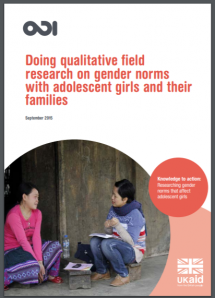Doing Qualitative Field Research on Gender Norms with Adolescent Girls and their Families
Qualitative research is particularly valuable for understanding gender norms that affect adolescent girls, because it allows people’s own perspectives and voices to come through, and gives the researcher a deeper, more nuanced understanding of the complexities involved in studying gender norms. By listening to what girls, their families and community leaders say, researchers can explore how people perceive the norms that pattern lives, and how they are – or are not – changing. These insights can be invaluable in challenging received wisdom about how gender norms affect adolescent girls in particular contexts.
There is already a great deal of guidance available on the principles and ethics of conducting qualitative research with children and young people. This Research and Practice Note adds to this body of work by drawing out some key pointers to bear in mind when undertaking qualitative research on gender norms with adolescent girls. It describes a step-by-step process for using four innovative or visual tools based on experience researching the impact of gender norms on adolescent girls in Nepal, Uganda and Viet Nam. It reflects on field experience of framing questions around social and gender norms, and links to the tools used throughout.
The four tools are:
- Group discussions (focusing on community mapping, body mapping, community timeline)
- Intergenerational trios
- Marital networks
- Outlier case studies
Source: Overseas Development Institute
Date of Publication: June 24, 2019
SIMILIAR RESOURCES
Tools
Examples
- Engager les Communautes pour explorer les normes sociales - Engaging Communities in Exploring Social Norms: Learnings from the Social Norms Exploration Tool
- Demand for Health Services: A Human-Centred Field Guide for Investigating and Responding to Challenges
- Map of Social Norms-focused Projects and Measurement Approaches
- Resources for Measuring Social Norms: A Practical Guide for Program Implementers
- What Does it Take? Operational, Cultural, and Structural Ingredients Necessary to Design for Girl-Centered Care
- Gender Transformation for Health A Participatory Toolkit
- Transform/PHARE
- Provider Behavior Change Implementation Kit
- Should We Use Entertainment Media to Shape Norms and Behaviors at Scale?
- Straight to the Point: Identifying and Prioritizing Behavior Change Needs

